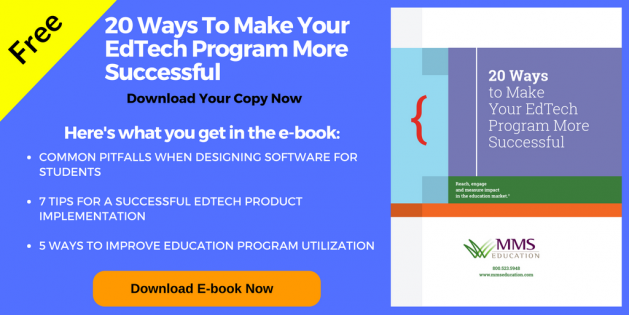If you’re reading this article, you’re probably thinking, “Tell me something I don’t know.” Of course, you’re supposed to know your audience. You may know yours well. This does not mean you can skip the important step of gathering user input for a new education software product or program before going to market.
In this digital world things change at a rapid pace, and so could the audience for your education program. We recommend you refresh or conduct new audience research before you launch a new education product program. It can shine a light on new opportunities that may not have existed last year or even last quarter. We find that you almost always uncover at least one nugget of valuable insight when you update your audience research.
At MMS, educators have been our focus for 40+ years and we know them well. Yet, we always recommend some level of discovery with end users before designing new tools or applications. When it comes to digital design, small insights into specific scenarios can make all the difference for success.
Here are some things to consider about educational software design:
- Define user groups: It’s best to get really specific about who will be using your software and when. Role, region, grade level, resources, environment, even in some cases subject, can introduce subtle but key differences. Learn how that particular user group gets their job done, uncover pain points and commonalities, and then design processes that are compatible with existing workflows.
- Gather end-user input: Surveys are helpful for broad strokes/ideas early on in discovery. Individual interviews are a valuable way to uncover insights that guide decisions about process flow and interface design. It’s helpful to be able to ask questions and better understand what is driving the feedback.
- Find out what’s most useful: Present users with a variety of functional concepts and ask if each would be helpful or not, how often they imagine they’d use it, etc. If you ask them to rate “usefulness” for each feature, that gives you a numerical way to compare user input and prioritize features.
- Identify motivators and barriers: Find out what would encourage, and prevent, them from using the software. This can inform not only the design but wording and marketing as well.
Software and digital projects tend to be under tight turnaround times. Sometimes teams are anxious to get started with development, and the discovery process can seem like an unnecessary delay. In our experience, user input is well worth the time and budget, doesn’t have to be costly to provide value, and can ultimately protect a launch date because it’s far easier to change direction during the design process. Studies have shown that one hour spent identifying issues with the user experience ahead of time, can prevent 100 hours of re-development later.
Clients choose MMS Education because of our deep understanding of the education market, backed by nearly 40 years of working with schools, systems, administrators, and agencies.
Call us today at 866-382-6116 or fill out this form to see how MMS Education can help you reach, engage, and measure impact in the PreK-12 education market.

